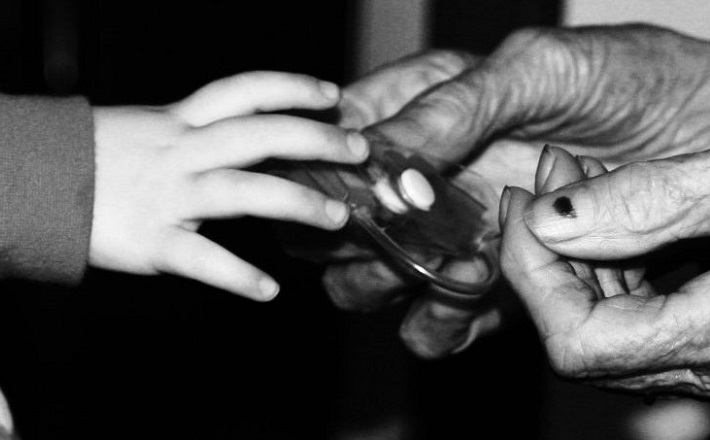Commentary on Mark 9:30-37
Mark’s intercalations (also known as “sandwiches”) are well known (e.g., Mark 5:21-43).
Mark also places stories side by side as way of making a point that could not have been achieved without such juxtaposition. For instance, the disciples’ lack of insight into Jesus’ identity after the calming of the storm, causing them to ask, “Who then is this?” (Mark 4:41) contrasts with the next story, in which a demon knows Jesus’ identity (Mark 5:7). In the passion narrative, the soldiers mock Jesus with a chant of “Prophesy!” (Mark 14:65). The very next story, in which Peter denies Jesus, provides a direct fulfillment of something that Jesus had indeed prophesied a few verses earlier (Mark 14:26-31).
We are well justified, then, to begin thinking about this gospel reading by looking at how the adjacent episodes can be read together. This reading in Mark 9:30-37 has two distinct episodes, although they are clearly linked as events that happened while travelling in Galilee.
In the first section (Mark 9:30-32), Jesus predicts his death and resurrection for a second time (the first was in Mark 8:31-33). Although the disciples’ reaction by this point is unsurprising, they have no idea what he is talking about. Their fear precludes them from even asking. Fear is ubiquitous in Mark. Characters repeatedly fear Jesus (Mark 4:35-41) or some manifestation of the Kingdom of God associated with him (Mark 5:1-20). Fear, in Mark’s gospel, is the paired opposite of faith. For example, in the calming of the storm, Jesus asks the disciples: “Why are you afraid? Have you still no faith?” (Mark 4:40). Jesus’ statement to Jairus about his dead daughter is similar: “Do not fear; just have faith” (Mark 5:36). Faith in Mark is not intellectual assent to a series of ideas or articles to be believed. Faith is more about what is in your gut, fortitude. In Mark 9:32 we see the disciples unable to ask Jesus about what confused them, which for Mark is emblematic of a lack of faith. In chapter 10 Jesus gives a third prediction of his death and resurrection, and fear will be the primary response once again (Mark 10:32-34).
The second episode confirms the disciples’ ignorance. Jesus asks them what they had been arguing about, and it turns out the topic had been who was the greatest. The fact that their time had been spent with apostolic jostling confirms just how hardened their hearts have become (an idea first suggested in Mark 6:52). Juxtaposing Jesus’ words about his coming suffering and their argument about who is the greatest is Mark at his ironic best and contributes to the continued depiction of the disciples and Jesus.
Jesus then describes what the kingdom of God is like, and how its “reality” is construed differently than any human reign. Those who are most honored in the Kingdom are the servants and those who are least. This idea has been shown time and again throughout the gospel; the kingdom breaks into the world in the least likely of places. The twelve disciples are constantly ignorant and afraid. Those who are successful are ostracized demoniacs and others who are possessed (Mark 5:1-20; Mark 7:24-30); bleeding women and dead girls (Mark 5:21-43); the sick (Mark 6:53-56); and those with disabilities (Mark 7:31-37).
This story in chapter 9 gives us another insight into what the kingdom is like — the reception of a child. The ancient world was infused with a strong sense of honor and shame. Those who were rich and powerful hoped to demonstrate their honor by the company they kept. At the same time, they could further curry favor and influence though highly respectable social relations.
Ramsey MacMullen, in his book, Roman Social Relations: 50 B.C. to A.D. 284, describes a sense of class in the ancient world that, although recognizable to us today, was of a scale that we might have a hard time imagining. The ancient world had no middle class. Most of the wealth was accumulated at the very top of the social structure, and the bulk of people found themselves poor. Within the elite world, honor was incredibly important. The components of honor and shame were common: “The upper classes emphasized, for everyone to notice and acknowledge, the steep, steep social structure that they topped” (MacMullen, 109). The rich wanted to associate only with other rich, they would intentionally insult and demean those who were slightly less rich, and hoped to accumulate favor with those who were above them.
Against such a backdrop, the words of Jesus in Mark’s gospel stand out. Saying that the way to gain honor is to receive those who are without honor goes against the logic of the ancient society. The Kingdom of God assesses and assigns value differently than the human realm. God will receive those who receive the child. This will give access to true power, the power of the one who sent Jesus.
While our modern society is different from the ancient one, there are several similarities and core anthropological dynamics we ought to consider. We seek status through cars, clothes, houses, titles, and electronics. When the Apple Watch was released, it was revealed that it came in aluminum, stainless steel, and gold versions. This is a piece of electronics that will be obsolete in 2 or 3 years. The only conceivable need for a $10,000 gold version is status, to proclaim to the world that money can be spent with no correlation to value. Actions we take every day may have ramifications on “the least” that we might never consider. Taking seriously the vision of the kingdom of God here in Mark’s gospel might cause us to consider those with whom we socialize, what food we eat, and whether we ought to water our lawns — decisions about which can impact the least among us.


September 20, 2015